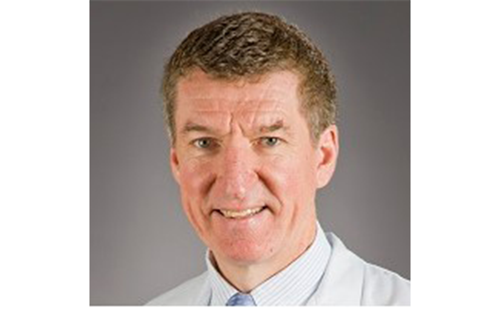touchPANEL DISCUSSION Paving the way for optimal disease control in moderate-to-severe type 2 asthma
Watch a panel of experts discuss the diagnosis of type 2 asthma, the rationale for biological therapy and emerging treatments.

Dr Michael Wechsler
National Jewish Health and University of Colorado, Denver, USA
CHAIR
Panelists:
Introduction
Dr Michael Wechsler chairs a discussion with Dr Flavia Hoyte and Prof. Dr Roland Buhl about the key pathogenic mechanisms underlying type 2 asthma that can be targeted with biologic therapy, which factors influence the choice of biologic therapy and the emerging biologics that may impact the management of patients with asthma.
view bio and disclosures 1/4 Next ChapterUnravelling the pathogenesis of type 2 asthma
Unravelling the pathogenesis of type 2 asthma
view bio and disclosures 2/4 Next ChapterIdentifying patients with type 2 asthma: Clinical and molecular considerations
The panel discusses the clinical features of a patient with type 2 asthma, the role of biomarkers in treatment selection and when they should be tested.
view bio and disclosures 3/4 Next ChapterBiologics in moderate-to-severe type 2 asthma: Current and future perspectives
The panel considers the latest efficacy and safety data for approved biologics and how emerging biologics may shape the landscape of available therapies for the management of type 2 asthma.
view bio and disclosures 4/4 Take CE/CME TestOverview & Learning Objectives
Overview
In this activity, a panel of experts in type 2 asthma discuss the evolving landscape of biological therapies and how to use different biomarkers to inform treatment choice and optimize patient outcomes.
This activity has been jointly provided by Oakstone and touchIME for touchIMMUNOLOGY. Oakstone Publishing is accredited by the ACCME to provide continuing medical education to physicians. read more
Target Audience
This activity has been designed to meet the educational needs of allergists, pulmonologists and immunologists involved in the management of type 2 asthma.
Disclosures
Oakstone Publishing has assessed conflict of interest with its faculty, authors, editors, and any individuals who were in a position to control the content of this CME activity. Any identified relevant conflicts of interest were resolved for fair balance and scientific objectivity of studies utilized in this activity. Oakstone Publishing’s planners, content reviewers, and editorial staff disclose no relevant commercial interests.
Faculty
Dr Michael Wecshsler discloses: Consultant/Speaker fees from AstraZeneca, GlaxoSmithKline, Sanofi/Regeneron/Genzyme. Speaker fees from CoheroHEalth, Cytoreason, Novartis, Genentech, Orbimed and Teva. DSMB Member fees from Sentien.
Dr Roland Buhl discloses: Lecturing/consulting fees outside submitted work from AstraZeneca, Berlin-Chernie, Chiesi, Cipla, Regeneron, Sanofi and Teva. Grants to Mainz University & personal lecturing & consulting fees inside submitted work from Boehringer Ingelheim, GlaxoSmithKline, Novartis and Roche.
Dr Flavia Hoyte discloses: Advisory Board Member fees from AstraZeneca. Speaker fees from GlaxoSmithKline. Grants/research support from AstraZeneca, Genentech, GlaxoSmithKline and Teva.
Content Reviewer
Walter Murray Yarbrough, MD, FACP has no financial interests/relationships or affiliations in relation to this activity.
Touch Medical Director
Alison Scott, PhD, has no financial interests/relationships or affiliations in relation to this activity.
Requirements for Successful Completion
This activity has been planned and implemented in accordance with the accreditation requirements and policies of the Accreditation Council for Continuing Medical Education (ACCME) through the joint providership of Oakstone Publishing and touchIME. Oakstone Publishing is accredited by the ACCME to provide continuing medical education for physicians.
The European Union of Medical Specialists (UEMS) – European Accreditation Council for Continuing Medical Education (EACCME) has an agreement of mutual recognition of continuing medical education (CME) credit with the American Medical Association (AMA). European physicians interested in converting AMA PRA Category 1 Credit™ into European CME credit (ECMEC) should contact the UEMS (www.uems.eu).
Oakstone Publishing designates this enduring material for a maximum of 0.5 AMA PRA Category 1 Credits™. Physicians should claim only the credit commensurate with the extent of their participation in the activity.
In order to receive credit for this activity, participants must review and complete the post-test and evaluation form. Statements of credit are awarded upon successful completion of the post-test and evaluation form.
Date of original release: 26 April 2021 . Date credits expire: 26 April 2022.
Learning Objectives
After watching this activity, participants should be better able to:
- Recognize the importance of biomarkers to identify patients with type 2 asthma accurately and promptly
- Outline the pathologic pathways underlying type 2 asthma and the differing mechanisms of action of available biologic therapies
- Recall the latest data for biologic therapies in moderate-to-severe type 2 asthma
Faculty & Disclosures

Dr Michael Wechsler
National Jewish Health and University of Colorado, Denver, USA
Michael Wechsler is Professor of Medicine in the Division of Pulmonary, Critical Care and Sleep Medicine at National Jewish Health (NJH) in Denver and Director of the NJH/Cohen Family Asthma Institute. read more
Michael Wechsler received AB and MMSc degrees from Harvard University in Boston and an MD degree from McGill University in Montreal. He completed medical training at Beth Israel Hospital in Boston, and as part of the Harvard Combined Pulmonary and Critical Care Fellowship Training Program.
In addition to clinical work in pulmonary & critical care medicine, Dr Wechsler’s work focuses on clinical and translational research in asthma with emphasis on clinical trials, novel asthma therapies, bronchial thermoplasty, asthma pharmacogenomics and management of eosinophilic granulomatosis with polyangiitis (EGPA, i.e. Churg–Strauss syndrome). He has led studies focusing on novel biologic agents for asthma and related diseases, including benralizumab, dupilumab, mepolizumab, reslizumab and tezepelumab. He has published more than 210 peer-reviewed manuscripts relating to asthma, EGPA and eosinophilic lung diseases.
Dr Wechsler was a member of the Steering Committee and site Principal Investigator (PI) of the NIH-sponsored Asthma Clinical Research Network (ACRN, now called AsthmaNet), a multicentre asthma clinical trials consortium. He currently serves as the PI of the Denver site of the Precision Intervention in Severe/Exacerbating Asthma (PRECISE) network. A member of the American Society of Clinical Investigation, he has participated in many different task forces related to the study of eosinophilic lung diseases that were sponsored by the National Institutes of Health, the Food and Drug Administration, the European Respiratory Society and the International Eosinophil Society. He is currently Associate Editor of the journal Chest and has served as Associate Editor of the journal Allergy and on the Editorial Board of the European Journal of Clinical Investigation.
Consultant/Speaker fees from AstraZeneca, GlaxoSmithKline, Sanofi/Regeneron/Genzyme. Speaker fees from CoheroHEalth, Cytoreason, Genentech, Novartis, Orbimed and Teva. DSMB Member fees from Sentien.

Dr Roland Buhl
Mainz University Hospital, Mainz, Germany
Roland Buhl, MD, is Professor of Medicine at Johannes Gutenberg University of Mainz and Head of the Pulmonary Department at Mainz University Hospital, Germany. read more
After qualifying in medicine and obtaining his Doctor of Medicine degree from the University of Heidelberg, Dr Buhl started his professional career at the Pulmonary Hospital in Berlin and then joined the Pulmonary Department at Frankfurt University Hospital, Germany.
In addition, he spent several years as a Research Fellow of the International Molecular Medicine Foundation at the Pulmonary Branch of the National Institute of Health, USA.
Dr Buhl’s research and main clinical interests focus on the pharmacology and management of chronic obstructive airway diseases, in particular, severe and difficult-to-treat asthma. He has published more than 300 peer-reviewed papers, book chapters, editorials and reviews on these topics and is actively involved in clinical trials investigating novel treatments.
He is a member of the GINA Science Committee, currently Chair of the German Asthma Guideline Committee and a member of the German Immunotherapy and COPD Guideline Committees.
Lecturing/consulting fees outside submitted work from AstraZeneca, Berlin-Chernie, Chiesi, Cipla, Regeneron, Sanofi and Teva. Grants to Mainz University & personal lecturing & consulting fees inside submitted work from Boehringer Ingelheim, GlaxoSmithKline, Novartis and Roche.

Dr Flavia Hoyte
National Jewish Health and University of Colorado, Denver, USA
Dr Flavia Hoyte is Associate Professor of Medicine in the Division of Allergy and Immunology at the National Jewish Health and University of Colorado, Denver. read more
Dr Hoyte graduated from Princeton University with a degree in Molecular Biology and Latin American Studies. She received her medical degree from New York University School of Medicine. She subsequently completed a combined residency in internal medicine and pediatrics at the University of Chicago Hospitals and a fellowship in allergy and immunology at National Jewish Health and the University of Colorado. Following graduation, she remained on faculty and currently serves as clinician; educator of residents and fellows; and clinical researcher in several investigator-initiated projects, network studies and company-sponsored trials.
Dr Hoyte specializes in adult allergic and immunologic conditions, asthma, and pulmonary conditions. Her research interests include novel diagnostic and therapeutic interventions for asthma. She was appointed Program Director for the National Jewish/University of Colorado Adult Allergy and Immunology Fellowship Training Program in 2015 and serves on the Clinical Leadership Council at National Jewish Health. She is a member of the Colorado Allergy and Asthma Society (CAAS); the Western Society of Allergy, Asthma and Immunology (WSAAI); the American College of Allergy, Asthma, and Immunology (ACAAI); and the American Academy of Allergy, Asthma, and Immunology (AAAAI).
Advisory Board Member fees from AstraZeneca. Speaker fees from GlaxoSmithKline. Grants/research support from AstraZeneca, Genentech, GlaxoSmithKline and Teva.

Register to touchIMMUNOLOGY for FREE
- Peer-reviewed journals and expert opinions.
- Interactive CME and e-learning modules.
- Video conference highlights.
